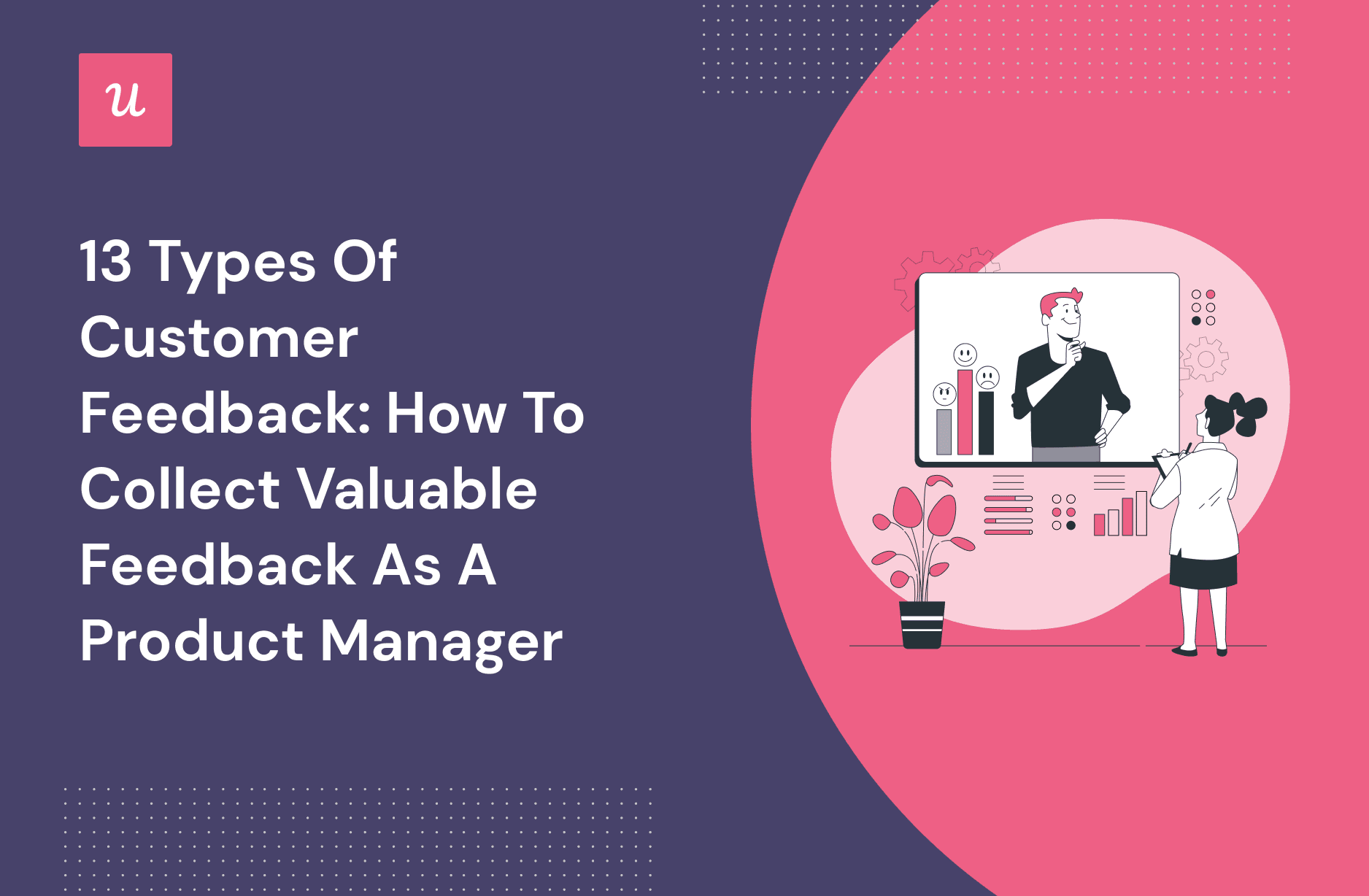
13 Types of Customer Feedback: How to Collect Valuable Feedback As a Product Manager
If you’re wondering what different types of customer feedback are and how to collect them, you’re in the right place!
In this article, we look at 13 different ways to collect feedback that product managers can leverage to gain a deep understanding of customer needs and make informed product decisions.
Let’s dive right into it!
What’s your primary goal for collecting different types of customer feedback?
- Improve new user onboarding
- Increase feature adoption
- Reduce churn / understand drop-off
- Measure customer loyalty (e.g., NPS)
How are you currently collecting feedback?
- Mainly email surveys and support tickets
- We use a mix of different third-party tools
- We don’t have a formal system yet
- We already use some in-app surveys
What’s your biggest challenge right now?
- Getting enough responses from the right users
- Analyzing feedback to find real insights
- Acting on feedback quickly enough
- All of the above!
See how to collect and act on feedback—all in one place.
Stop guessing. Userpilot helps you collect all types of customer feedback (like NPS, CES, and feature requests) contextually inside your app, analyze trends, and act on them instantly with in-app guidance.
Try Userpilot Now
See Why 1,000+ Teams Choose Userpilot

What is customer feedback?
Customer feedback is all the information and opinions that you get from your customers about their experiences with the product.
This includes positive feedback, which highlights the aspects of the product that satisfy user needs, as well as negative customer feedback. The latter focuses on those parts of the user experience which don’t live up to their expectations.
Active feedback vs passive feedback
A solid customer feedback strategy must include active and passive feedback methods.
What is active feedback?
Active feedback is the kind of feedback that you solicit actively from your users. For example, this could be through regular NPS surveys or feature surveys triggered in-app.
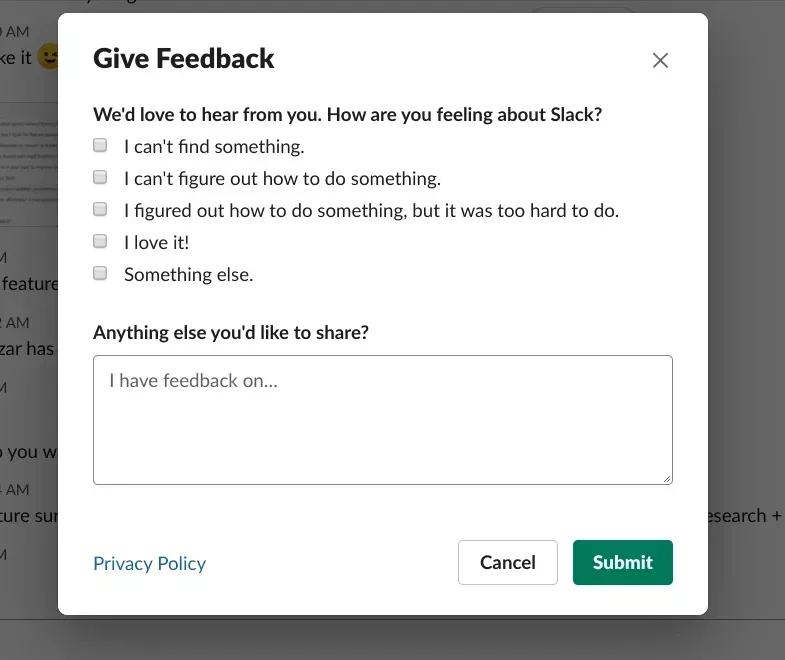
What is passive feedback?
Passive feedback is a kind of on-demand feedback.
Whenever users would like to share their opinions, request a feature or report a bug, they can do it via a feedback widget located in your resource center or in a visible place on your product dashboard.

13 Types of customer feedback and how to collect them
There are multiple types of customer feedback. For example, positive and negative customer reviews on public sites like G2 or Captera can be invaluable sources of information.
However, in this article, we’ll be focusing only on the feedback that’s relevant to product managers.
User onboarding feedback
User onboarding feedback helps you evaluate the quality of the onboarding experience you’re offering to your users.
This type of customer feedback allows you to personalize the onboarding experience for your users, remove friction from the process and reduce the time to value.
How to collect user onboarding feedback?
Onboarding feedback is normally collected via in-app surveys at the end of the onboarding process. For example, they could be triggered by an activation event.
To increase the response rate, the survey should consist of a short question focusing on overall satisfaction with the experience. You should also follow it up with a qualitative question that will help you understand better how they’re feeling about the onboarding process.
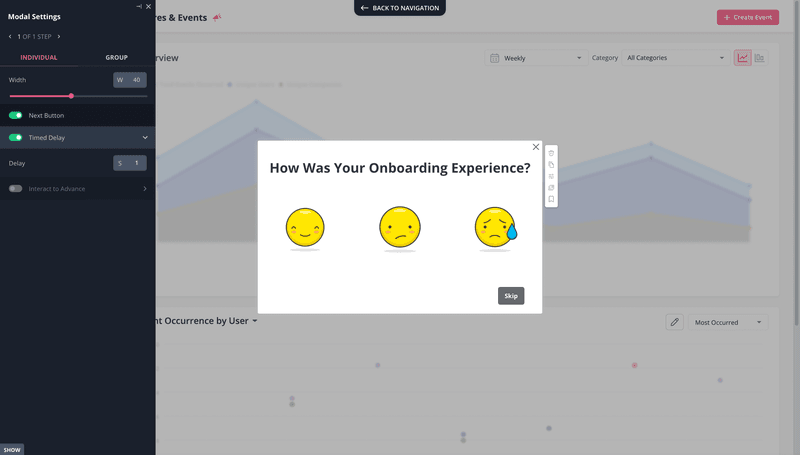
Product feedback
Product feedback helps you improve your product so that it fully satisfies user needs and delivers a more satisfying experience. Acting on product feedback will not only help you retain existing customers but will make it more attractive to prospective ones.
How to collect product feedback?
Popular product feedback collection methods include customer interviews, focus groups, and usability testing.
Each of these methods has its strengths and limitations, so ideally you should use a combination of them to get a more complete picture.
For example, usability testing can help you make the UI more intuitive while user interviews can help you understand why users act in a particular way.
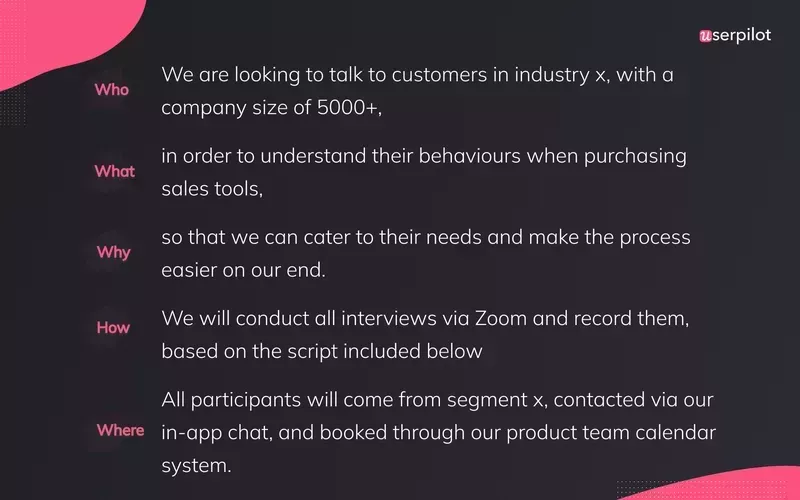
Feature requests
Feature requests give you ideas on how you can make the product more competitive and delightful for your users.
Apart from that they can also be an indication of inadequate product onboarding.
How so?
If users ask for a feature that you already have or one with existing functionality, it means it’s relevant to their use cases and yet they’ve not been able to discover it.
How to collect feature requests?
The easiest way to collect feature requests is via a feature request survey or the passive feedback widget. Customer-facing roadmaps are another good way to do so. You can create them in a project management tool like Trello and share them with your users.
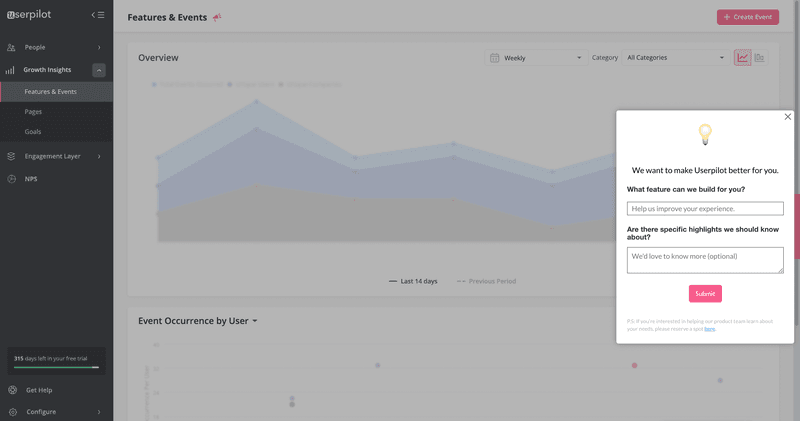
Customer preference feedback
Customer preference feedback gives you insights into what customers like and what they don’t.
Such knowledge can help you make more accurate product development decisions. If your users prefer one UI design or one feature over another, that’s what you should prioritize in your backlog.
How to collect customer preference feedback?
Focus groups are one popular way to collect customer preference feedback. However, they are time-consuming to organize and the outcomes could be affected by groupthink.
In-app surveys are way easier and cheaper to run and you can target a wider consumer base to get more representative opinions.
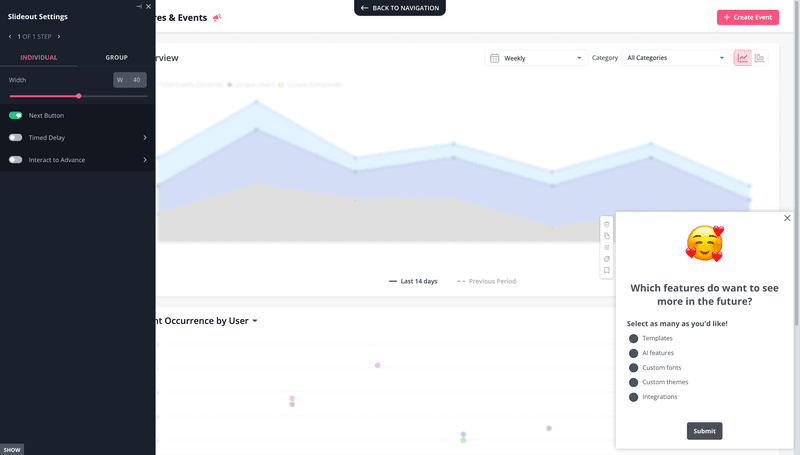
In-app rating feedback
In-app rating feedback is a quick way to evaluate user satisfaction with a particular experience without leaving the app.
For example, you could use it to ask users to evaluate a template or a feature they’ve just used. Such feedback shows not only how valuable the feature is for the user but if you can find a way to share it with other users, for example in your app store, it can increase its visibility.
How to collect in-app ratings?
In-app rating feedback is easy to collect. All you have to do is create a pop-up modal with a simple rating scale.
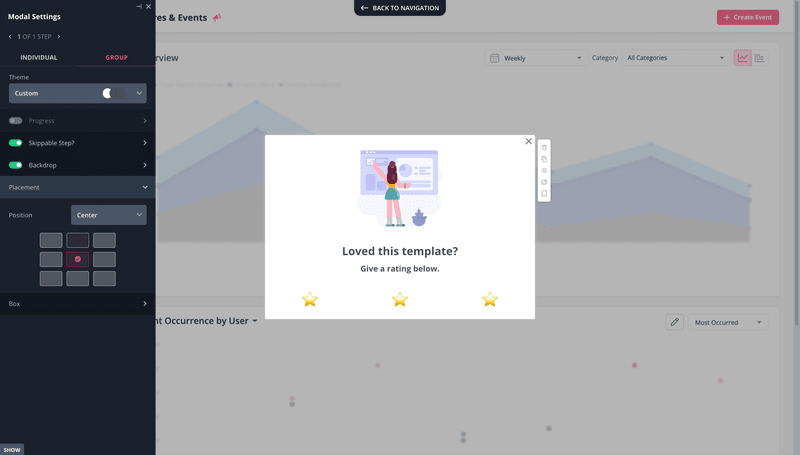
Customer loyalty feedback
Customer loyalty feedback enables teams to assess how emotionally attached your customers are to your product or brand.
This kind of feedback is valuable because it helps you estimate how likely your customers are to stay with you, or even actively promote your product.
How to collect customer loyalty feedback?
Net Promoter Score (NPS) surveys are a common way to collect customer loyalty feedback.
You can also trigger these NPS surveys directly in your mobile app, effortlessly gathering valuable user insights on-the-go.
This kind of user feedback survey asks customers how likely on a scale from 1 to 10 they are to recommend the product to their friends or colleagues. Based on the answers, it classifies users into promoters, passives, and detractors.
It’s good practice to follow up on this with a qualitative question to ask for more detailed insights. Ideally, the tool you use should let you tag and analyze the qualitative NPS answers so that you can segment your users effectively and spot trends in their opinions.
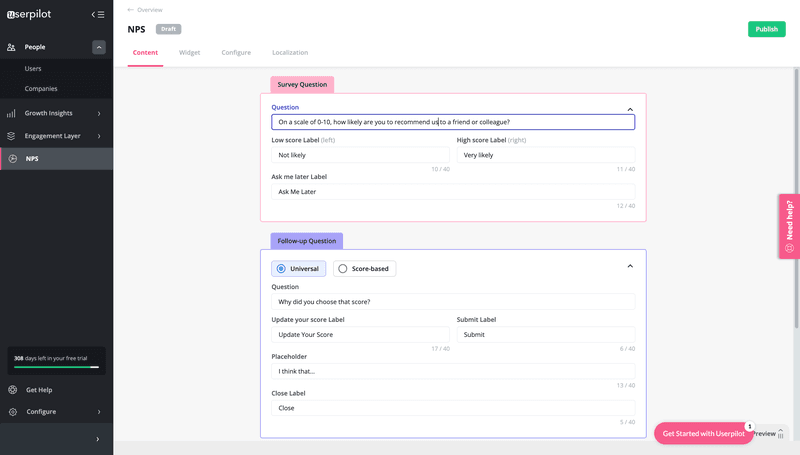
Customer satisfaction surveys
Customer satisfaction feedback tells you how happy your users are with the product experience and the value it offers.
Such surveys can highlight areas that need improving in your product and opportunities to add value and delight.
How to collect customer satisfaction feedback?
To measure customer satisfaction, we use surveys that are very similar to NPS ones. You ask your users how satisfied they are with the experience and give them a Likert scale to rate it.
Ideally, you should trigger this contextually just after the experience so that it’s still fresh in their minds. This will give you more accurate results and will increase the response rate.
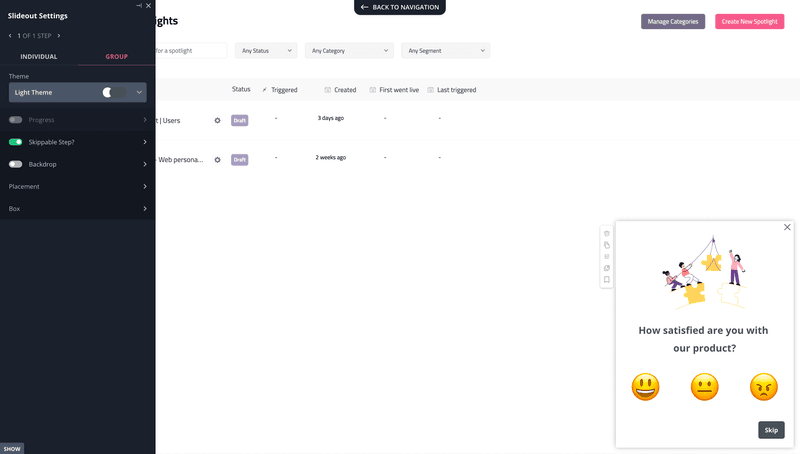
Customer experience feedback
Customer experience feedback is a kind of satisfaction feedback. It focuses specifically on user interactions with your product at different touchpoints in the customer journey. It helps you evaluate how easy it is for the customer to complete their tasks with the product.
How to collect customer experience feedback?
Product managers often use Customer Effort Score (CES) surveys to collect customer experience feedback. The survey basically asks users to rate how easy it was for them to accomplish their objective.
You can run these surveys when the users reach a milestone in the customer journey or use a feature for the first time.
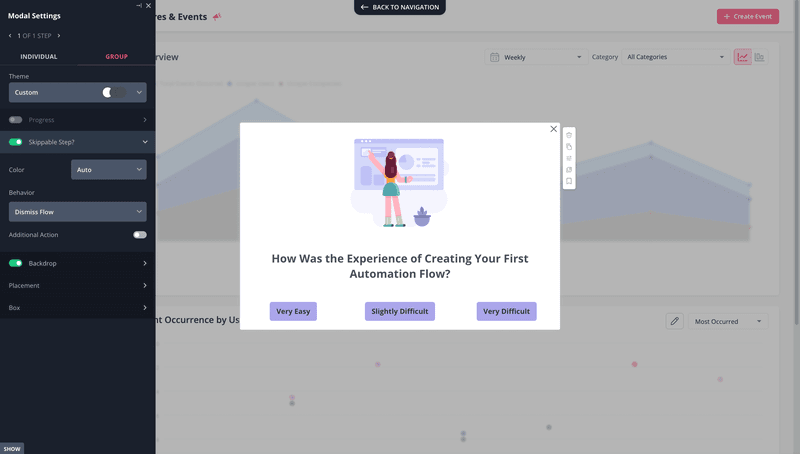
Product viability feedback using PMF survey
Product viability feedback allows you to assess how successful your product is at satisfying a genuine market need.
For products to be viable, there need to be enough customers ready to pay for a product that solves their problem. That’s how you achieve product-market fit.
How to collect product viability feedback?
To collect viability feedback, teams use PMF surveys, also known as Sean Ellis tests.
The test is a bit subversive. Instead of asking how happy customers are with the feature or product, it asks them how disappointed they’d be if they couldn’t use them again. If 40% of your users respond ‘very disappointed’, you’ve got it. If not, you need to keep iterating on your MVP.
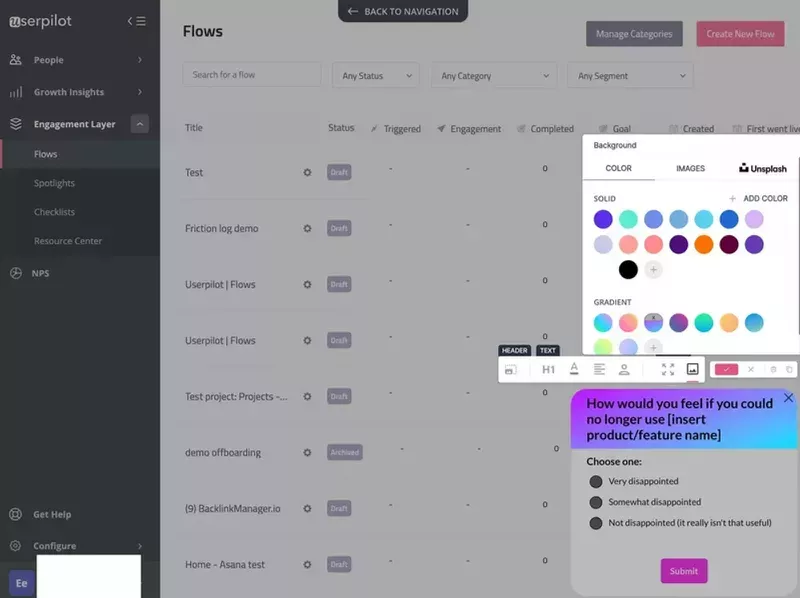
Bug reports
Bug reports tell you about the technical issues that spoil the user experience.
Product managers can’t afford to ignore these because they result not only in customer churn but also cause irreparable damage to the product and brand reputation.
How to collect feedback on bugs?
To collect bug reports, use a feedback widget like the one you use to collect customer requests or passive feedback.
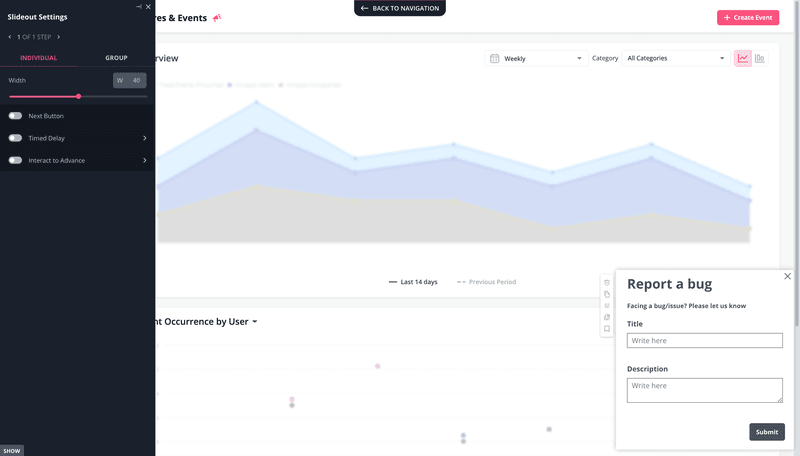
Customer service feedback
Customer service feedback helps teams evaluate how effective the customer support teams are at dealing with customers. It also helps you identify issues with the product and user experience that you need to rectify.
This kind of feedback could include complaints but it’s not limited to negative feedback. Positive feedback helps you identify and promote successful practices.
How to collect customer service feedback?
Customer service feedback normally comes from support teams. These are the people who deal with customers on a daily basis so they are aware of the barriers and problems that they face.
Monitoring and reviewing support tickets also offers valuable insights into the quality of customer service. Using a complaint tracking tool like Zendesk or Freshdesk will help you manage customer complaints efficiently.
Understand customer expectations with sales feedback
Your sales team is another customer-facing team that can provide you with valuable knowledge about customer expectations.
That’s because salespeople tend to be well-trained in questioning techniques and they are great at extracting from customers what they need. They may be able to tell you about the unsolved pain points that customers face or gaps in the market that you could fill.
How to collect sales feedback?
The most obvious way to collect this kind of feedback is from sales calls.
Indirectly, you could also obtain this kind of feedback by monitoring subscription cancellations. An increase in cancellations could indicate that the product stopped delivering the expected value or that there is a more attractive competitor around.
Subscription cancellation feedback
The feedback your customers leave as they’re about to cancel their subscription or downgrade their plan can shed light on how your product fails to satisfy their needs.
It can give you ideas on how you can improve the product and the user experience to reduce churn and give insights into the shifts in the competitive market.
How to collect subscription cancellation feedback?
Churn surveys are a kind of microsurvey that target users who have canceled their paid plan or are about to do this. They can be delivered by email or in-app.
The advantage of the latter is that it also gives you a chance to win the customer back. You can do this by highlighting what the users are going to miss out on when they proceed with the cancellation.
In your survey, include the option to add their own reason for leaving you not just a constrained list. In this way, you increase the chance of unearthing new issues.
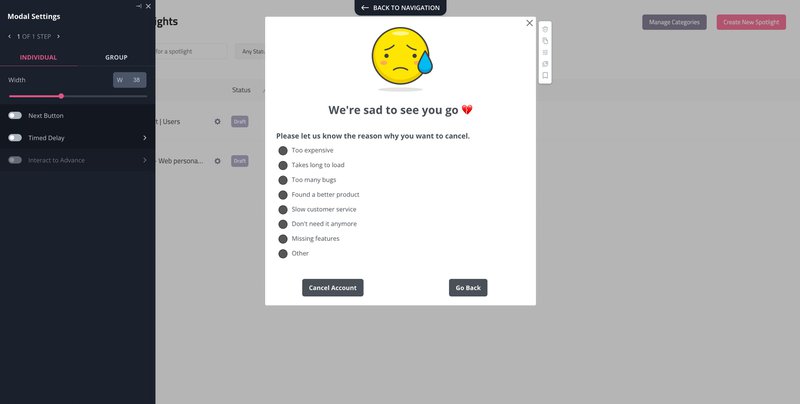
Close the customer feedback loop after collecting feedback
Collecting feedback only makes sense when you are ready to act on it.
What do we mean by acting on it?
- Use in-app messages to acknowledge the feedback so that users know you’ve received it and appreciate it.
- Tag and group similar responses together to quantify them and spot trends.
- Reach out to your users to gain more detailed insights into their experience.
- Cross-reference user feedback results with product usage and customer behavior data to identify successful and unsuccessful practices. For example, look at how your power users or most loyal customers engage with the product and where they get value from.
- Check the requests for alignment with the product vision. Act only on the feedback that will help you realize your product goals. Otherwise, you will spread your resources thin and damage the value proposition.
- Once you implement changes, use in-app communications to bring your users up-to-date. Don’t forget about the inactive users. Try to reengage them with emails.
- Start collecting feedback as soon as you implement any changes.
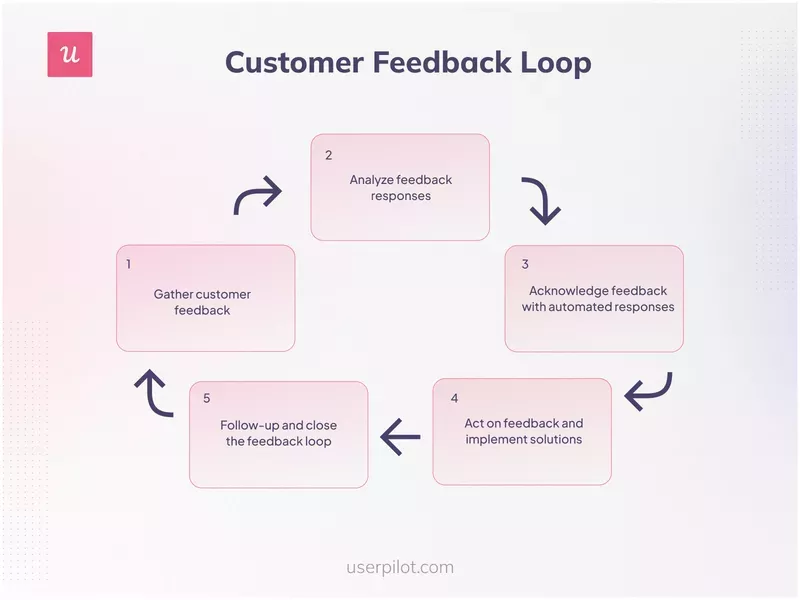
Conclusion
There are quite a few types of customer feedback that product managers can leverage to make informed product decisions.
Its good practice to collect customer feedback from various sources and use it in conjunction with product usage data to better understand customer behavior.
No matter how much feedback you collect, it’s not much use if you don’t close the feedback loop and act on it.
If you want to see how Userpilot can help you collect and analyze various types of customer feedback, book the demo!







